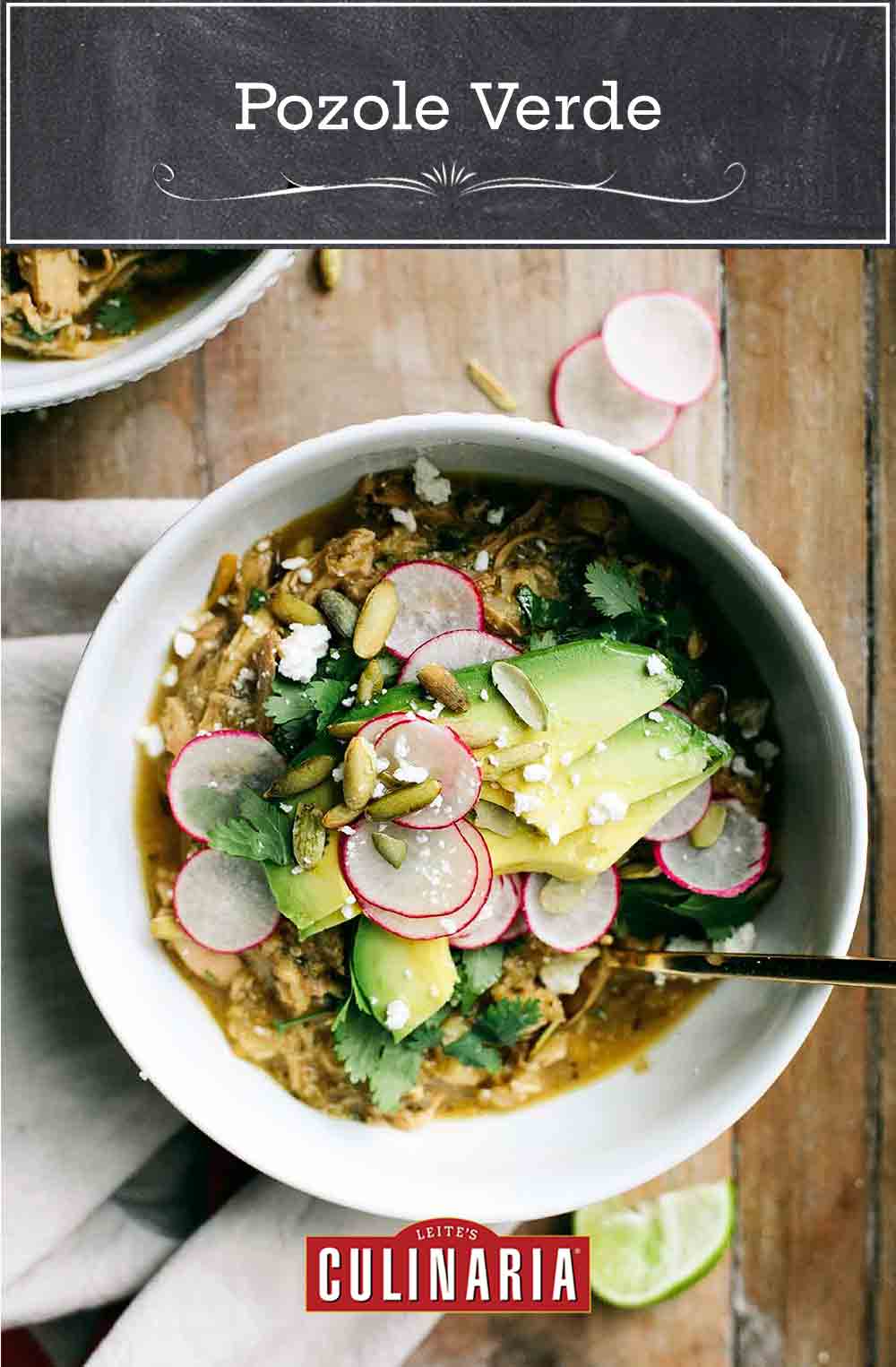
This pozole verde recipe is based on one that appeared in Gourmet magazine years ago but has seen quite a lot of tweaks. The reality of the recipe is that it’s quick and easy, and leftovers reheat spectacularly for lunch at work the next day. As for the taste, suffice it to say, it tastes authentic as heck despite not requiring you to stand at the stove for hours on end. No complaints here.–David Leite
Pozole Verde FAQs
You can. While fresh is typically desired, using canned tomatillos can expedite preparation. Goya has both whole and crushed tomatillos in a 26 oz can – we’d recommend whole for this recipe – and you’d only need about half of the can. You can freeze the rest for another day. Add the tomatillos after you’ve cooked the onions down a bit, then carry on with the recipe as instructed below.
Cotija cheese is a salty, milky-tasting cheese. We use it almost interchangeably with feta as the taste and texture are so similar. Cotija can be moist or hard, depending on how long it’s been aged. It crumbles wonderfully on top of soups, salads, and other dishes.

Pozole Verde
Ingredients
- 1/2 cup roasted, salted pepitas (hulled pumpkin seeds), plus more for garnish
- 1 teaspoon cumin seeds, toasted
- 2 tablespoons vegetable oil
- 10 ounces tomatillos (about 5 of varying sizes), husks removed and discarded, tomatillos rinsed and quartered
- 3 garlic cloves
- 1 large yellow onion, roughly chopped, plus more for serving
- 1 jalapeño pepper, halved and seeded
- 1/2 cup chopped cilantro leaves, divided
- 1 to 1 1/2 teaspoons kosher salt
- 1 teaspoon dried oregano
- 2 1/2 to 3 cups homemade chicken stock or canned chicken broth
- 4 to 6 boneless, skinless chicken thighs (1 pound), thinly sliced
- One (15-ounce) can hominy (posole or pozole), drained and rinsed
- Thinly sliced radishes, sliced avocado, chopped cilantro, lime wedges, diced onion, crumbled Cotija, and sour cream or crema, for serving
Instructions
- Toss the pepitas and cumin seeds in a spice grinder, coffee grinder, or blender and blitz until finely ground.
- Heat 1 tablespoon oil in a large pot or Dutch oven over medium-high heat. When the oil is hot but not smoking, add the tomatillos, garlic, onion, and jalapeño along with a pinch of salt. Cook, stirring occasionally, until everything is lightly charred, caramelized in places, and tender throughout, which should take 10 to 15 minutes.
- Dump the charred vegetables in a food processor or blender along with 1/4 cup (5 grams) chopped cilantro and 1 teaspoon salt and purée until the desired consistency, whether chunky or smooth.
- Return the pot to medium heat and add the remaining 1 tablespoon oil. Pour the purée into the pot and gently simmer, stirring frequently, until thickened, 5 to 7 minutes. Be sure to scrape the bottom of the pot to release the deeply flavored browned stuff clinging to the pot. Stir in the ground pepitas and cumin seeds along with the oregano and 1 cup (240 milliliters) stock. Bring to a simmer and then add the remaining 1 1/2 cups (360 milliliters) stock, chicken, and hominy. Cover partially and gently simmer for 20 minutes.
- Stir in the remaining 1/4 cup (5 grams) chopped cilantro. Taste and adjust seasonings, adding more salt if you feel it needs it. Some prefer pozole to be thick, like stew, but if you prefer it thinner, add more stock. Ideally you would let it cool, cover, and refrigerate it overnight or up to 3 days prior to rewarming over low heat and serving. Leftovers can be refrigerated for up to 1 week. Serve with the accompaniments.

Explore More with AI
Nutrition
Nutrition information is automatically calculated, so should only be used as an approximation.
Recipe Testers’ Reviews
This was a wonderfully delicious recipe! I was craving Mexican flavors and had a pack of chicken thighs in the freezer, so figured I would give it a shot. What I didn’t expect was how easily it would come together and how scrumptious it would be. My husband and I started with a bowl each, which left about 2 servings in the pot, but then we went back for seconds and finished it completely. So it feeds 2 hungry monsters or 4 normal people. I made it in the afternoon and let it set out on the stove for about 2 hours before we reheated it for dinner. Even my 3 1/2-year-old loved it and requested more. We served it with avocado, sour cream, queso fresco, and a squeeze of lime. I don’t like cilantro but decided to use it as directed. Surprise, surprise—I loved it! The ingredients were pretty easy to find, and next time, I might even add more jalapeño for extra heat. One note: My pot is black on the bottom. It’ll take some extra Bar Keepers Friend to get this Le Creuset pot back to it’s usual pretty self.
Smoky, tangy, nutty, crunchy, and sweet, this green pozole is precisely how I envisioned it. Topping it with sliced avocado and radishes and drizzling it with lime juice made it a perfect meal for a cold, rainy day. A generous sprinkle of black pepper added to the complexity and heat of the dish.
I planned game day Sunday around serving this pozole verde and was very glad that I did! I enjoyed this different take on pozole that used tomatillos and pumpkin seeds as the base. The directions, including timing and amounts of ingredients, worked very well, and I really didn’t feel the need to try and do anything differently. The most fun part about this soup, though, is all the different garnishes and toppings. Try to include at least 3 for variety in texture in your pozole.
I was so pleased that this pozole verde recipe came together so quickly yet tasted so complex. Prior to starting, I was thinking that my oven-roasted method for tomatillos was going to be better than the stated method, but there was plenty of char and caramelization achieved on the stovetop. The ground pepitas gave a great background nuttiness to the dish while also thickening the soup. The chicken thighs were cooked after 20 minutes. A great weeknight recipe that, as stated, tastes even better warmed up for a work lunch the next day. We enjoyed it with all the condiments, including some finely chopped fresh jalapeño since we like spicy. It did need a bit more salt, and I plan on adding another 1/2 teaspoon cumin seeds next time I make it. It tasted a bit like a fresh tamale in stew form. Husband requests repeat performance!
This pozole verde recipe is a keeper! While I love pozole in almost any form, a weeknight version that has depth and body is a super alternative to multi-day versions (which, while wonderful, don’t get made that often). The pan-roasting method achieved much of the same effect as oven-roasting but was more efficient and more thoroughly caramelized the onions. I liked the addition of the ground pepitas, which is something I hadn’t tried, but now I’m a convert! This pozole has a nice heat (I used a large jalapeño) and a good balance of chicken and hominy. My large can of hominy was a bit more generous than the recipe called for, so I used 4 cups chicken broth. That also allowed us to be a little greedy the first time we served it and still have leftovers for a great brunch the next day. The timing is good on this. My chicken slices were on the thick side (closer to 1/2 inch thick) ,yet they cooked through fine. If you want much thinner slices, I would suggest popping the thigh meat in the freezer for 20 minutes before slicing. I used avocado oil—it behaves well, even at higher temperatures, and is very neutral. The result is superb—not just a chicken hominy soup, but something really approaching the rich toothiness of proper pozole yet on the table in less than 90 minutes. You can do much of the prep, like slicing the chicken, while the vegetables are cooking. Next time, I might use a little broth to deglaze before adding the oil and purée back into the pot to capture even more fond—not a huge issue, just obsessively looking to maximize flavor. I’d also start with some Rancho Gordo white corn posole if I have the time—soaking then cooking the posole would take longer, but the subtle difference of the limed corn is worth the time when you have it. If you’re lucky enough to have leftovers, poach an egg in it for a lovely brunch! Either way, serve it with thinly sliced radishes, cotija, lime as suggested, avocado if you have it, and expect this to be a frequent request for dinner!
It’s delicious. It’s different. I have known pozole only as a somewhat clear soup. This is much more like a stew, thickened and a bit creamy. We absolutely loved it. The recipe worked well. Since I didn’t have roasted pepitas, only raw ones, I roasted them in a dry pan on medium heat for 6 minutes. It’s a good idea to put a splash guard over the pan, as they get a little jumpy. It took 8 minutes to get the tomatillos and onions charred. I used the immersion blender to purée them, which worked very well. After adding the chicken, I let the pozole simmer for 30 minutes. The chicken was cooked through and very tender. Served it with radishes, avocado, roasted pumpkin seeds, lime wedges, and onion. Omitted the cheese and sour cream.
This recipe created the perfect meal for a snowy winter’s day. The aroma and flavors were really warming. Topping it with avocado, onion, cilantro, and a squeeze of lime made it perfectly hearty without feeling like a nap was necessary afterwards. Another check on the plus side is how quickly it came together—it left plenty of time to curl up under a warm blanket and watch a movie (my idea of the perfect winter Sunday afternoon). I wasn’t able to get a really fine ground on the pepitas because they started to clump together, so it created a slight grainy broth, which I didn’t mind.
Best thing about this recipe? Grinding the pepitas and cumin seeds into a powder thickens the soup into to a stew and adds a delicious nuttiness. I’ve made my share of pozole, and this technique is truly unique to my experience with the dish. I employed my trusty Dutch oven for the task, which is a great tool when I need to get the heat up high and hot for some caramelization and char. After 15 minutes, the vegetables were charred and fragrant with black bits here and there. The next few steps went off without a hitch. (Tip: Add 1 cup chicken stock to the blender that you puréed the tomatillos in first before adding it to your pot. Give the stock a whirl in the blender jar to pick-up all of the leftover vegetable purée at the bottom, which always manages to eludes us under the blades.) I let my pozole simmer for a final 20 minutes, which was plenty of time to cook the chicken through. I served the dish with all my faves: radishes, diced onion, creme, and a squeeze of lime. Since there is minimal chopping of vegetables and the cooking process only uses a single pot and your blender, I’d say this a great weekday meal with added value in butt-kicking leftovers for office lunch.
I really enjoyed this recipe. I’ve made other pozole recipes before, but this one stuck out. I thought grinding the pepita seeds and adding them to the soup was really interesting. The seeds thickened the soup and added a slight nuttiness. The recipe was very easy to follow and took less than an hour. I didn’t have to do any adjusting; I just added a little extra salt at the end. The garnishes you choose to add to your soup can add some nice flavor and texture. I used avocado, cilantro, and a touch of hot sauce.
My co-worker brought pozole for lunch last week, and the fragrance was intoxicating and inspirational. I had no choice but to make this recipe! It’s so simple and comes together in less than an hour. Charring the vegetables adds a smoky undertone that is rich and satisfying. (It’ll also make your eyes water and your cat sneeze, though. At least, mine did.) The finished soup is a lovely, herby, thick broth with chunks of chicken. It could use a squeeze of citrus before serving. The recipe doesn’t make a lot—I’d say that 4 servings is a stretch—but that’s fine for a single person like me. If you’re making this for your family, I’d double it.
Thick and full of texture, this posole was way more interesting then we expected. Tomatillos, pumpkin seeds, and hominy cinched the title for most unusual soup ingredients so far. Don’t let that deter you from making this comforting, hearty meal-in-a-bowl. It’s a quick way to keep ’em guessing when you announce that dinner is chicken soup. The most time-consuming part of this recipe is up front—sautéing the vegetables, using the blender (twice), and then cooking what you blended. After that, it’s a dump-and-wait situation. Thinly sliced thighs cook quickly, and the hominy just needs to warm through. Careful, though—they direct you to use a big pot but my Dutch oven was way too big for the job. Next time, I’ll opt for a medium saucepan, more like 2 quarts. While the soup simmers, you’ve got plenty of time to set the table and prepare the garnishes; we used radishes, cilantro, and lime wedges. Next time I’ll include avocado, too. This served 2 generously for dinner with no sides, with leftovers for both of us at lunch the next day. Adding more stock and an extra can of hominy could easily stretch this without increasing the chicken or vegetables (and then you’ll need that bigger pot!).
I love the flavors of Mexican verde sauce with all the tomatillos, lime, and cilantro. I also love a good pozole. So this sounded like a winning combination that uses chicken instead of pork for pozole. The recipe delivers on that promise and makes a delicious and comforting bowl of food. The combination of the earthy, salty pepitas with tart tomatillos and fragrant cilantro works great. The pepitas ensure that there’s enough texture and body in the stew and keeps it from being too soupy. I served this with all the listed accompaniments and added a few freshly toasted corn tortillas as well for some crispy texture. The chicken was cooked in 20 minutes, but since it’s thighs, it can cook for significantly longer if needed and will just get more tender.
Loved, loved, loved this pozole verde recipe! You know something is good when you wake up thinking about it and change the meals for the week to make it again. All the ingredients work together to give you a dish that is just beautiful. And, if that wasn’t a ringing enough endorsement, it’s quick and easy to make. Canned hominy? I questioned how good that could be. I used a can of fancy white hominy for this, and it was not at all soft or mushy. It worked perfectly with everything else. I can’t see me soaking and cooking dried hominy ever again. The chicken was indeed cooked through after simmering for 20 minutes. Having all of the toppings available for serving is the way to go, as it’s a lot of fun to try bowls (or spoonfuls!) with different things on top. Since jalapeños vary so greatly in heat, I would also make hot sauce available.
This was simply fantastic! Classic comfort food that was completely elevated by so much flavor. Wow. Will be making this again and again. My only other comment about the recipe was the part where the onion, jalapeño, and tomatillo mixture gets blended. This was an excellent technique and resulted in a great texture. I went with a mixture that was still quite chunky. This yielded a great pozole, and we all really liked the texture. I think processing until smooth would make it more like a soup.


















Delicious! I made yesterday and my whole family loved it.
Wonderful, Blitzo! Thanks so much for taking the time to let us know.